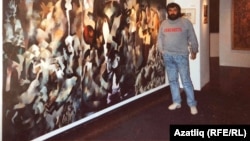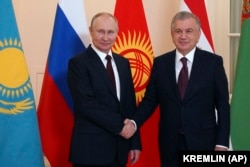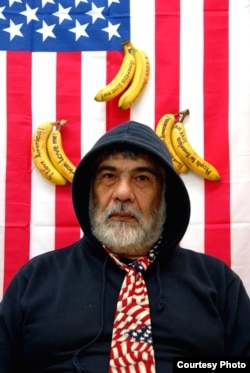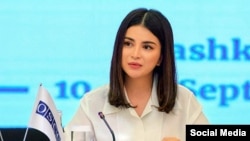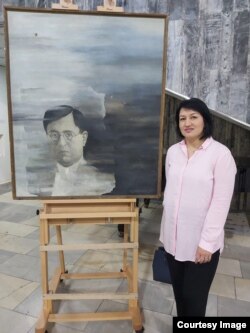The forms covering the seven-meter wide, two-meter high abstract painting float in a scene of violent chaos where domed roofs, falling figures, and disembodied hands jump out of the canvas.
“When They Bombed Bukhara” is former dissident Uzbek artist Vyacheslav Akhunov's 1987 depiction of the Bolsheviks' 1920 bloody assault on the fabled Silk Road citadel of the same name -- an air and ground operation that unseated the last emir of Bukhara and asserted communist control over the city.
Last week, the artwork was supposed to end its more than three-decade exile from Uzbekistan to take its place at an exhibition in the state art museum in Tashkent.
But that didn’t happen and when Akhunov -- who had brought the painting to Uzbekistan from New York -- visited the museum, he found his artwork tightly guarded and wrapped in cellophane.
“They came up with all sorts of excuses, like that the museum hadn’t had time to document the painting before the exhibition. But I knew that wasn’t the case because another painting of mine -- the portrait of the poet Abdulhamid Chulpon -- was included in the exhibition.”
Akhunov has his own theory as to why plans for the exhibit suddenly changed.
“Most likely there are some officials here who are sympathetic to Russia and didn’t want to irritate Moscow,” he told RFE/RL.
“Perhaps they thought that a painting showing how the Bolsheviks dropped bombs on a city where people had never seen airplanes before would recall the current situation with the war in Ukraine,” Akhunov said.
Fraught Histories
The apparent standoff over Akhunov’s painting comes at a time when debates over Russia’s colonial legacy in Central Asia are even more fraught than usual thanks to Moscow’s unprovoked and bloody invasion of Ukraine, which began in February 2022.
Central Asian governments typically tread a difficult line between accommodating popular demands to readdress periods of history under Moscow’s yoke and irritating a country that remains an important and sometimes capricious partner.
But it is rare that Moscow openly criticizes states that it considers its close partners over their approach to historical events, noted Sergei Abashin, a historian and anthropologist at the European University in St. Petersburg, who specializes in Central Asia.
“Clearly we have a much more emotional Kremlin at the moment, with the war in Ukraine, but they are still somewhat pragmatic, so I doubt any Russian official or even the embassy raised any objections about Akhunov’s painting,” Abashin told RFE/RL.
At the same time, Abashin said, it is not out of the question that a high-up Uzbek official “decided to exercise caution” in relation to the artwork, despite the fact that Uzbek President Shavkat Mirziyoev’s own daughter, Saida Mirziyoeva, had played a not insignificant role in facilitating Akhunov’s participation in the exhibition.
The first half of last century is particularly rich in contested history in Central Asia – from Tsarist crackdowns through the state-induced famine that killed more than 1 million people in Kazakhstan in the 1930s and the Stalinist repression that wiped out some of Central Asia’s leading lights.
The Bolsheviks’ capture of Bukhara, aided by resistance to the emir inside the city and reinforced with a shock and awe, air-and-ground assault that claimed thousands of lives, is another dramatic event from this period.
In an article marking a century since the operation, news website Eurasianet noted that the leader of the operation, Red Army commander Mikhail Frunze, remains a villain in modern-day Bukhara.
“He is known, particularly among younger generations, as the man whose bombing destroyed the city’s now-reconstructed Ark, the heaving fortress memorialized in countless propaganda paintings and movies,” Eurasianet wrote.
Akhunov suggested in comments to RFE/RL that the new deputy director of the state museum, a Russian national called Mikhail Ovchinnikov, might have had a hand in the decision not to exhibit his painting.
Ovchinnikov previously worked in the Faberge Museum in St. Petersburg, Akhunov noted, which was founded by Viktor Vekselberg, a Russian oligarch who was placed under U.S. sanctions after the Kremlin’s February 2022 invasion.
The museum in Tashkent has released no statement on the matter.
But Akhunov said the apparent censorship has led to a surge of interest in his painting.
“Everybody has been asking me how they can see it,” he said, laughing.
Paintings With Stories
Whatever the truth, both When They Bombed Bukhara and Akhunov’s portrait of the repressed Uzbek poet Abdulhamid Sulaymon-ughli Chulpon -- which did appear in the exhibition last week -- say something about modern-day Uzbekistan as well as Moscow’s legacy in the region.
When They Bombed Bukhara was painted at a time when Mikhail Gorbachev’s policy of glasnost (openness) was allowing more scope for artistic expression, and Akhunov was able to display it in Tashkent – where pro-communist artists criticized it strongly – before taking it to London to exhibit it.
He then gave it to a relative who took it to the United States, where it remained until last month.
But, by the time Uzbekistan’s independence came around, the painting would not have been welcome in Tashkent anyway.
That is because of Akhunov’s close friendship with Muhammad Salih, a popular, opposition-minded writer and poet who challenged Karimov in Uzbekistan’s first-ever presidential election.
Solih lost, alleging massive ballot-rigging in Karimov’s favor, and was forced out of Uzbekistan.
He would later be sentenced in absentia on terrorism charges that were widely viewed as politically motivated.
Akhunov’s portrait of Chulpon, which he had gifted to Salih, disappeared after the election, having been embroiled in a scandal a few years earlier.
“In 1988, Salih was elected chairman of the Union of Writers,” Akhunov recalled.
“One of his first actions in his new office was to take down the portrait of Lenin and replace it with my portrait of Chulpon. Even at that time [during glasnost] it was a tremendously daring thing to do. The communists were livid.”
In 2009, Akhunov was reunited with his old friend in Istanbul, where Salih was living and where Akhunov was exhibiting at the Istanbul Biennial.
When he returned home, Akhunov was informed by the authorities he would no longer be able to travel abroad.
That travel ban remained in force until Karimov’s death and the arrival in power of Uzbekistan’s current leader, Karimov’s reform-touting successor and protege, Mirziyoev.
The bid to find the portrait of Chulpon and exhibit both works in Tashkent began some time ago and was spearheaded by YUZUK, an Uzbek cultural collective based in Germany.
Their efforts were later supported by a foundation chaired by 38-year-old Mirziyoeva, who holds a post in her father’s administration and has used her political heft to promote artistic and cultural causes.
Eventually, the portrait was found in February of this year in Tashkent and handed over to YUZUK’s Dilbar Gaffarova in March.
Gaffarova told RFE/RL that the portrait of Chulpon had gone through at least seven owners since the days when it had hung on the wall at the Union of Writers in Tashkent.
“There was a hole on the canvas, a layer of thick dust, and another layer of dirt. I took the painting home to Akhunov before it was handed over to the museum. He cleaned the painting with a weak solution,” Gaffarova said.
Akhunov, meanwhile, told RFE/RL that, while he believes some positive changes have occurred in the Mirziyoev era, the situation surrounding the exhibit has added to his pessimism about the direction the country is traveling in.
“Reforms are facing extreme difficulty. Corruption is massive. Resistance to change is a huge problem,” he said.




